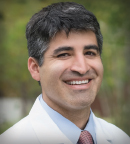In the primary analysis of the phase III ZUMA-7 trial, examining second-line therapy for relapsed or refractory large B-cell lymphoma, the CAR T-cell therapy axicabtagene ciloleucel led to a fourfold increase in event-free survival over the standard of care. These findings were presented at the Plenary Session of the 2021 American Society of Hematology (ASH) Annual Meeting & Exposition.1
“The results of ZUMA-7 herald a paradigm shift in how we treat large B-cell lymphoma,” said Frederick L. Locke, MD, Vice Chair, Department of Blood and Marrow Transplant and Cellular Immunotherapy and Program Co-Leader, Immuno-Oncology at Moffitt Cancer Center, Tampa, Florida.

Frederick L. Locke, MD
Axicabtagene ciloleucel has been approved by the U.S. Food and Drug Administration as a third-line therapy for large B-cell lymphoma. ZUMA-7 evaluated its benefit in the second-line setting as compared with platinum-based chemotherapy followed (where possible) by hematopoietic autologous stem cell transplant (HSCT).
At a press briefing, Dr. Locke emphasized the benefits observed with this chimeric antigen receptor (CAR) T-cell therapy in ZUMA-7: “ZUMA-7 is the first randomized CAR T-cell trial with 24.9 months of median follow-up. In it, -axicabtagene ciloleucel showed superiority over the standard of care, with more than a fourfold greater median event-free survival, a 2.5-fold greater 2-year event-free survival, a 33% higher objective response rate, double the rate of complete responses, and nearly three times the number of patients receiving definitive therapy, vs the standard of care.”
Dr. Locke continued: “By giving CAR T-cell therapy as an earlier line of treatment, we are able to reduce the amount of chemotherapy patients are exposed to and get them quickly to a definitive therapy that may eradicate lymphoma for many years, if not forever, without a stem cell transplant.” Dr. Locke called the improvement in event-free survival in the second line “remarkable” and said patients not responding to initial treatment or relapsing within 12 months should have the opportunity to be treated with this agent.
About ZUMA-7
For patients with large B-cell lymphoma relapsing after first-line chemoimmunotherapy, second-line chemoimmunotherapy or HSCT is indicated, but many patients are not candidates for either of these approaches. Outcomes for these patients have been poor, and CAR T-cell therapy is considered a promising strategy.
Axicabtagene ciloleucel, which targets CD19, is approved for relapsed or refractory large B-cell lymphoma after two or more systemic therapies. The global phase III ZUMA-7 trial evaluated it as a second-line strategy by studying 359 patients who relapsed within 12 months of first-line chemoimmunotherapy and were transplant-eligible. Three-quarters had primary refractory disease, and about half had a high age-adjusted International Prognostic Index.
Patients were randomly assigned to receive axicabtagene ciloleucel, given as a single infusion of 2 × 106 CAR T cells/kg after conditioning with cyclophosphamide and fludarabine or platinum-based chemotherapy, or platinum-based chemotherapy, followed in responders by HSCT. Of 140 patients given axicabtagene ciloleucel, 94% underwent successful infusion. Of the 179 on the control arm, 64 (36%) reached transplantation. The primary endpoint was event-free survival by blinded central review.
KEY POINTS
- The phase III ZUMA-7 trial evaluated CAR T-cell therapy with axicabtagene ciloleucel as a second-line treatment of relapsed or refractory large B-cell lymphoma.
- In the primary analysis, this treatment led to a fourfold increase in event-free survival over the standard of care.
- At a median follow-up of about 25 months, median event-free survival was 8.3 months with axicabtagene ciloleucel vs 2.0 months with standard therapy (hazard ratio = 0.398; P < .0001).
- The treatment was also associated with a fivefold increase in response rate and a trend toward improved overall survival.
Patients not responding to the standard treatment could cross over to receive CAR T-cell therapy off protocol. Patients received their infusions a median of 29 days after randomization, and CAR T-cell levels peaked about 1 week later.
Of note, optional bridging treatment was limited to corticosteroids, a design feature that Dr. Locke emphasized in the press briefing as a way to ensure the cleanest data: “We wanted to give axicabtagene ciloleucel without the confounding effects of chemotherapy, which we know can cause a response,” he said. The TRANSFORM study of lisocabtagene maraleucel as second-line therapy, also presented during the ASH meeting,2 did allow chemotherapy bridging.
Event-Free Survival Quadrupled
At a median follow-up of 24.9 months, the study’s primary endpoint was met: treatment with axicabtagene ciloleucel resulted in a median event-free survival of 8.3 months vs 2.0 months with the standard of care (hazard ratio [HR] = 0.398; P < .0001). The 24- month estimated event-free survival rate was 41% vs 16%, respectively, Dr. Locke reported.
Objective response rates were significantly higher with the CAR T-cell therapy than with standard second-line treatment: 83% vs 50% (odds ratio = 5.31; P < .0001), and complete response rates were similarly increased, at 65% vs 32%, respectively. Median overall survival was not reached, whereas it was 35.1 months in the control arm (HR = 0.730; P = .027), but this endpoint has not yet met statistical significance. This is thought to be at least partly due to an imbalance in subsequent therapy: 56% of the control arm crossed over to receive a commercially available or investigational CAR T-cell therapy off protocol, and for 78% of patients, this was axicabtagene ciloleucel.
No Unexpected Toxicities Reported
Grade ≥ 3 treatment-emergent adverse events occurred in 91% of the experimental arm and 83% of the control arm, with one and two deaths each in those arms, respectively. In patients treated with axicabtagene ciloleucel, grade ≥ 3 cytokine-release syndrome occurred in 11 patients (6%), and grade ≥ 3 neurologic events were reported in 36 patients (21%); none was grade 5. In the chemotherapy arm, febrile neutropenia occurred in 27%.
“For both study arms, the rates and types of adverse events were consistent with expectations based on previous trials and real-world experience,” Dr. Locke commented.
ZUMA-12 Trial: Axicabtagene Ciloleucal in the First-Line Setting
Axicabtagene ciloleucel was evaluated in the phase II ZUMA-12 trial as a first-line treatment of high-risk patients with large B-cell lymphoma. Results of ZUMA-12 were also presented at the ASH meeting by Sattva S. Neelapu, MD, Professor and Deputy Chair in the Department of Lymphoma/Myeloma at The University of Texas MD Anderson Cancer Center, Houston.3

Sattva S. Neelapu, MD
In the primary analysis, 89% of the 37 evaluable patients achieved a response, including 78% with complete responses, at a median follow-up of 15.9 months. At data cutoff, 73% had ongoing responses, and the medians for duration of response, event-free survival, and progression-free survival were not reached. The 12-month estimates for these endpoints were 81%, 73%, and 75%, respectively.
“The ZUMA-12 data indicate that axicabtagene ciloleucel is very promising in an area of high unmet need—the front-line setting of patients with high-risk large B-cell lymphoma,” Dr. Neelapu said.
DISCLOSURE: Dr. Locke reported financial relationships with Allogene Therapeutics, Amgen, Bluebird Bio, EcoR1, Emerging Therapy Solutions, Gerson Lehrman Group, Iovance Biotherapeutics, Takeda, Novartis, Wugen, GammaDelta Therapeutics, Umoja, Cellular Biomedicine Group, Calibr, Cowen, BMS/Celgene, Legend Biotech, Kite, and Janssen. Dr. Neelapu reported financial relationships with Kite, Merck, Bristol Myers Squibb, Novartis, Celgene, Pfizer, Allogene, Kuur Therapeutics, Incyte, Precision Biosciences, Legend, Adicet Bio, Calibr, Unum Therapeutics, Poseida Therapeutics, Cellectis, Karus Therapeutics, Bluebird Bio, Sana Biotechnology, Sellas Life Sciences, and Acerta.
REFERENCES
1. Locke FL, Miklos DB, Jacobson C, et al: Primary analysis of ZUMA-7: A phase 3 randomized trial of axicabtagene ciloleucel versus standard-of-care therapy in patients with relapsed/refractory large B-cell lymphoma. 2021 ASH Annual Meeting & Exposition. Abstract 2. Presented December 12, 2021.
3. Kamdar M, Solomon SR, Arnason JE, et al: Lisocabtagene maraleucal, a CD19-directed chimeric antigen receptor CAR T cell therapy, versus standard of care with salvage chemotherapy followed by autologous stem cell transplantation as second-line treatment in patients with relapsed or refractory large B-cell lymphoma: Results from the randomized phase 3 TRANSFORM study. 2021 ASH Annual Meeting & Exposition. Abstract 91. Presented December 11, 2021.
3. Neelapu SS, Dickinson M, Munoz J, et al: Primary analysis of ZUMA-12: A phase 2 study of axicabtagene ciloleucel as first-line therapy in patients with high-risk large B-cell lymphoma. 2021 ASH Annual Meeting &. Exposition. Abstract 739. Presented December 13, 2021.



